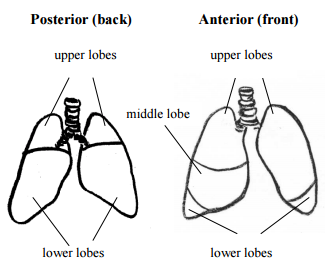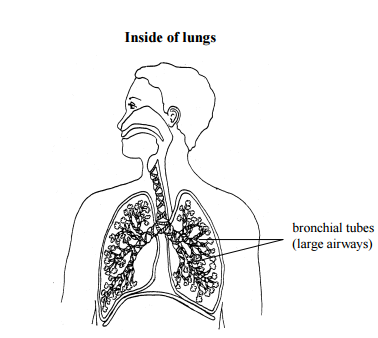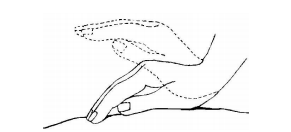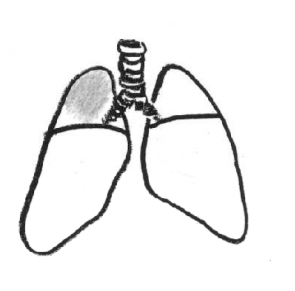Chest physiotherapy using trendelenberg (age 2 and older)
What is chest physiotherapy?
Chest physiotherapy (CPT) is a way to help get mucus out of the lungs. The lobes of the lungs, both back and front, are shown below.


There are two parts to CPT bronchial drainage and percussion. Do CPT only after you have been taught by a Respiratory Therapist.
Bronchial drainage (BD) is positioning the body to allow gravity to help in moving themucus. Different positions are used so that the area to be drained is highest. Using trendelenberg means positioning the head and chest lower than the hips.
Percussion or clapping is tapping the chest wall rhythmically to loosen mucus and move it into the bronchial tubes (large airways) of the lungs.
How do I prepare my child?
The air pocket created between the hand and the chest makes a popping sound. Although this procedure is noisy, if your hands are cupped properly it will not hurt your child.
- Explain what your child will hear and feel.
- Explain what you are going to do using language your child will understand.
- Show your child on a doll what you are going to do.
- Reassure and praise your child throughout the procedure and when you are done.
How should I do CPT?
The doctor will decide what positions your child will need for CPT, and how often to do the therapy. Schedule it before or at least 1 hour after eating.
- To make percussion more comfortable, your child should wear a thin layer of clothing such as a shirt, or you may use a blanket or towel over the skin. Do not percuss on bare skin.
- Place your child on a padded surface, using blankets or pillows for positioning and support. Use the checked positions.
- Percuss each area rhythmically and vigorously.
For small children, use a CPT cup.
For older children use cupped hands.
- Percuss ___ minutes in each position as directed.
- Percuss only over the ribs. Avoid percussing over the spine, breastbone, stomach, lower ribs, and lower back to prevent injury to body organs.
What else do I need to know?
Percussion is less tiring if you keep your arms relaxed and do the movement with your wrists.
If your child has trouble with a position (poor color, hard time breathing, fighting it), sit him or her up until breathing returns to normal, and try again. If you have tried a position 3 times and your child still has trouble, go on to the next position. If you cannot give the full therapy again at the next session, call the doctor.
Various mechanical devices may be used for percussion. If your child needs CPT often, you may want to consult your doctor or therapist for advice.
When should I call the doctor?
- Fever
- Coughing up fresh blood
- Hard time breathing
- Lip or nail color becomes blue or gray
- You are unable to give a complete therapy session twice in a row
Questions?
This sheet is not specific to your child, but provides general information. If you have any questions, please call the doctor.
Use the positions checked below:
Note: your therapist may teach you to adjust some of these positions to meet your child's needs.
___ 1. Right and left upper lobes – apical segments
Child is sitting up with back supported. Percuss just below the collarbones.


___ 2. Right and left upper lobes – anterior segments
Child lies on the back with a pillow under the knees. Percuss between the collarbone and nipple on both sides.


___ 3. Right upper lobe – posterior segment
Child lies on left side with a pillow under the left armpit. Have child lean forward at a 45° angle against the pillow. Percuss on the top part of the right shoulder blade.


___ 4. Right and left lower lobes – superior segments
Child lies with pillows under abdomen (belly) and legs. Percuss on the bottom of, and just below, the shoulder blades.


___ 5. Left upper lobe – posterior segment
Child lies on right side with a pillow under the right armpit. Have child lean forward at a 45° angle against the pillow. Percuss on the top part of the left shoulder blade.


Note: For positions 6 through 9, the head and chest should be lower than the hips.
___ 6. Right and left lower lobes – anterior segments
Child lies on the back with a pillow under the knees. Percuss both sides just below the nipple and above the lower ribs.


___ 7. Right lower lobe – lateral segment
Child lies on the left side with a pillow under the left lower ribs and hip. Percuss below the right armpit and above the lower ribs.


___ 8. Right and left lower lobes – basal segments
Child lies with pillows under abdomen (belly) and legs. Percuss below the shoulder blades and above the lower ribs.


___ 9. Left lower lobe – lateral segment
Child lies on the right side with a pillow under the right lower ribs and hip. Percuss below the left armpit and above the lower ribs.


Children's Hospitals and Clinics of Minnesota
Patient/Family Education
2525 Chicago Avenue South
Minneapolis, MN 55404
Reviewed 6/2015 © Copyright
This page is not specific to your child, but provides general information on the topic above. If you have any questions, please call your clinic. For more reading material about this and other health topics, please call or visit Children's Minnesota Family Resource Center library, or visit www.childrensmn.org/educationmaterials.
© 2024 Children's Minnesota
